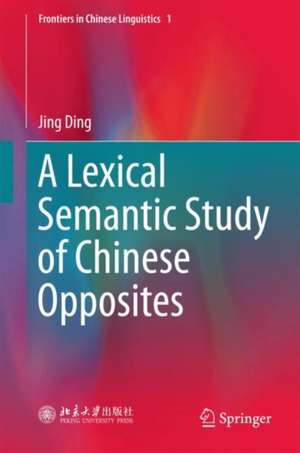A Lexical Semantic Study of Chinese Opposites: Frontiers in Chinese Linguistics, cartea 1
Autor Jing Dingen Limba Engleză Hardback – 5 dec 2017
This study appeals to linguists, computational linguists and language-lovers. With numerous tables, illustrations and examples, it is easy to read but also encourages readers to link their personal instincts with the results from a large corpus to experience the beauty of language as a shared human resource.
| Toate formatele și edițiile | Preț | Express |
|---|---|---|
| Paperback (1) | 357.86 lei 38-44 zile | |
| Springer Nature Singapore – 11 feb 2019 | 357.86 lei 38-44 zile | |
| Hardback (1) | 361.50 lei 38-44 zile | |
| Springer Nature Singapore – 5 dec 2017 | 361.50 lei 38-44 zile |
Preț: 361.50 lei
Nou
Puncte Express: 542
Preț estimativ în valută:
69.17€ • 71.36$ • 57.73£
69.17€ • 71.36$ • 57.73£
Carte tipărită la comandă
Livrare economică 22-28 martie
Preluare comenzi: 021 569.72.76
Specificații
ISBN-13: 9789811061837
ISBN-10: 9811061831
Pagini: 135
Ilustrații: XIX, 135 p. 22 illus., 19 illus. in color.
Dimensiuni: 155 x 235 mm
Ediția:1st ed. 2018
Editura: Springer Nature Singapore
Colecția Springer
Seria Frontiers in Chinese Linguistics
Locul publicării:Singapore, Singapore
ISBN-10: 9811061831
Pagini: 135
Ilustrații: XIX, 135 p. 22 illus., 19 illus. in color.
Dimensiuni: 155 x 235 mm
Ediția:1st ed. 2018
Editura: Springer Nature Singapore
Colecția Springer
Seria Frontiers in Chinese Linguistics
Locul publicării:Singapore, Singapore
Cuprins
1. Introduction.- 1.1 Motivations.- 1.2 Research Questions.- 1.3 Organization of Chapters.- 2. Literature Review.- 2.1 Definition and Categorization.- 2.2 Some Properties of Being Opposites.- 3. Opposites in Constructions.- 3.1 Research Question.- 3.2 Methodology, Candidate List and Corpus.- 3. 3 Results.- 3. 4 Discussion.- 3.5 Summary.- 4. Opposites in Discourse.- 4.1 Research Question and Previous Experiments.- 4.2 Methodology, Candidate List and Corpus.- 4.3 Result.- 4.4 Discussion.- 4.5 Summary.- 5. Opposites and Negation.- 5.1 Research Question.- 5.2 Methodology, Candidate List and Corpus.- 5.3 Result.- 5.4 Discussion.- 5.5 Summary.- 6. Conclusion.
Notă biografică
Dr. Jing Ding is presently a research fellow at the School of International Education, South China University of Technology. She received her PhD from The Hong Kong Polytechnic University, Hong Kong SAR, in 2015. Her main research interests are lexical semantics and computational linguistics. She has published papers in the Proceedings of the Chinese Lexical Semantics Workshop.
Textul de pe ultima copertă
This book studies Chinese opposites. It uses a large corpus (GigaWord) to trace the behavior of opposite pairings’ co-occurrence, focusing on the following questions: In what types of constructions, from window-size restricted and bi-syllabic to quad-syllabic, will the opposite pairings appear together? And, on a larger scale, i.e. in constrained-free contexts, in which syntactic frames will the opposite pairings appear together? The data suggests aspects that have been ignored by previous theoretical studies, such as the ordering rules in co-occurrent pairings, the differences between the three main sub-types of opposites (that is, antonym, complementary, converse) in discourse function distributions. The author also considers the features of this Chinese study and compares it to similar studies of English and Japanese. In all, it offers a practical view of how opposites are used in a certain language as a response to the puzzles lingering in theoretical fields.
This study appeals to linguists, computational linguists and language-lovers. With numerous tables, illustrations and examples, it is easy to read but also encourages readers to link their personal instincts with the results from a large corpus to experience the beauty of language as a shared human resource.
Caracteristici
Presents a practical discussion based on a large corpus, making it different from the previous theoretical studies Provides a new perspective for looking at the differences of three main types of opposites Includes observations on the features of Chinese opposite pairings Includes supplementary material: sn.pub/extras










